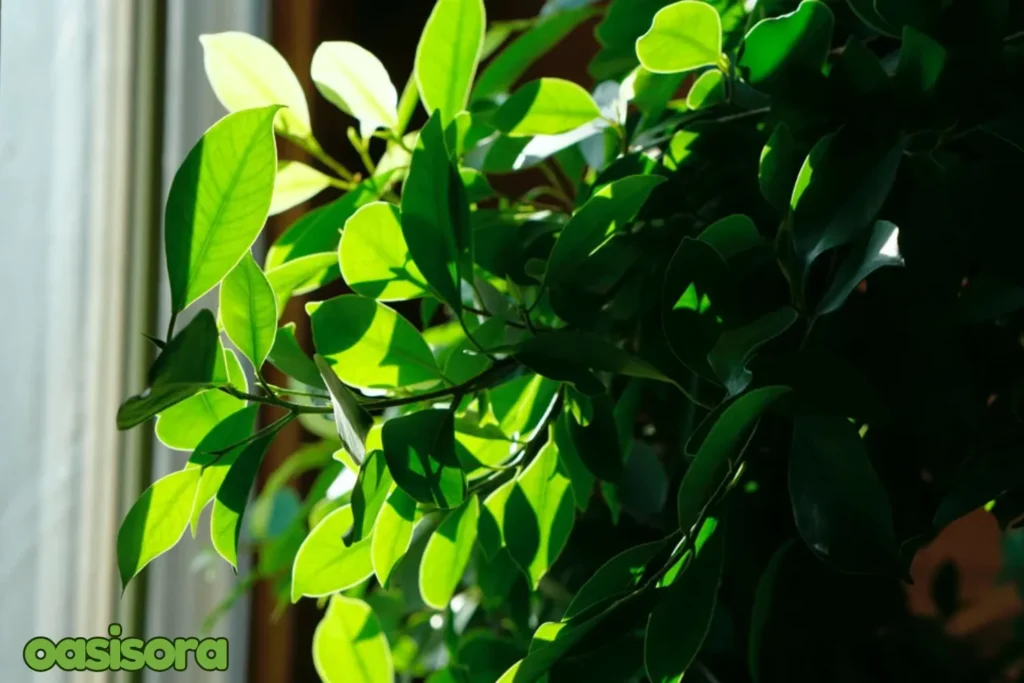
Arizona’s high temperatures might be unbearable, especially if you want to enjoy your outdoor area. Fortunately, the best shade trees for Arizona may leave a significant impact. They can enhance the visual appeal of your house and provide a more comfortable and cool atmosphere. We may offer you a feasible choice if you’re tired of resisting the sun. These 12 of Arizona’s best shade trees can keep you cool and make your yard a tranquil haven.
Why Shade Trees Are Essential for Arizona Landscapes?
Nevertheless, shade trees are an effective way to deal with Arizona‘s intense heat. They enhance comfort, make your outdoor areas more pleasant, and give an amazing look to any yard. These trees are crucial to a beautiful and stable landscape.
Combat the Heat
By blocking the intense desert heat, shade trees assist in decreasing the temperature in the area around your house. On hot days, they provide a cool, shaded refuge where you may calm down. As a result, your yard will become more comfortable and attractive.
Energy Efficiency
You can minimize the quantity of sunshine that reaches your house by strategically arranging trees. This lowers energy use and improves indoor temperatures. As a result, you’ll face fewer cooling expenses and a more enjoyable household.
Environmental Benefits
Shade trees benefit wildlife by offering them food, shelter, and air purification. They maintain the quality of the air by eliminating pollutants and dust. Such plantations further assist in making the natural world green and healthy for everybody.
Top 12 Shade Trees for Arizona Landscapes
Use these 12 best shade trees for Arizona to convert your yard into a relaxing and cozy place. Every tree adds beauty and relief from the extreme heat, making them perfect for the desert environment.
1. Desert Museum Palo Verde (Parkinsonia ‘Desert Museum’)
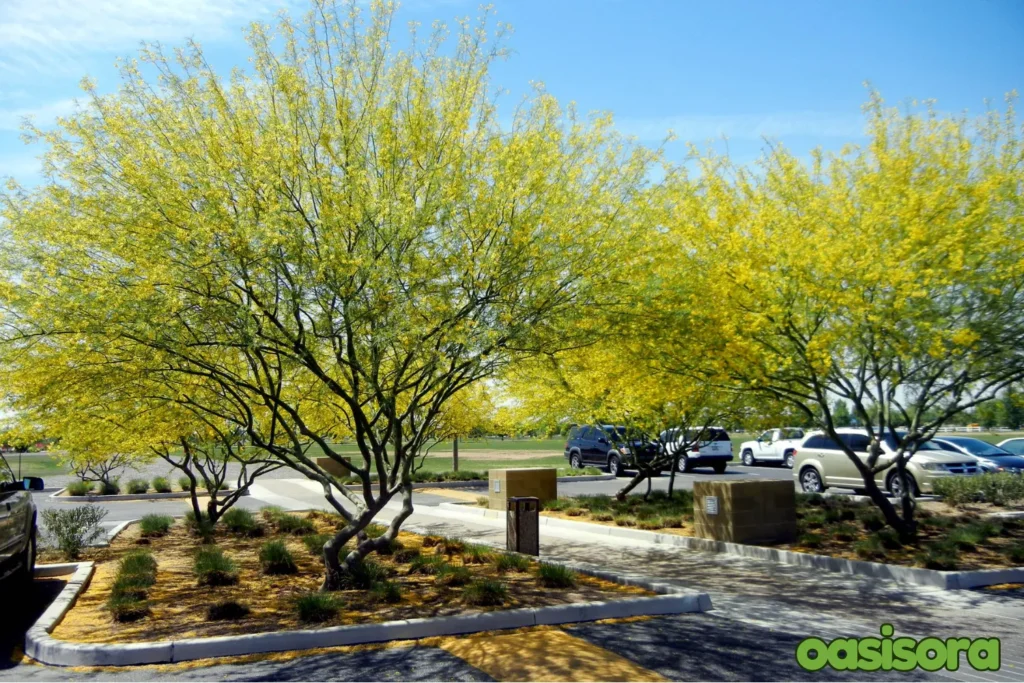
Desert Museum Palo Verde
The Desert Museum Palo Verde is set out by its striking green branches and stem, which are elegantly combined with bright yellow blooms.
It expands to a height of 25 feet and is ideal for Arizona’s environment because it grows in full sun.
- Key Features: A hybrid form of the Arizona state tree, having a long blooming season with bright yellow blooms, and an amazing green trunk.
- Benefits: It consumes a low quantity of water, grows rapidly, consequently requires low maintenance, and gains attraction.
2. Chilean Thornless Mesquite (Prosopis chilensis)
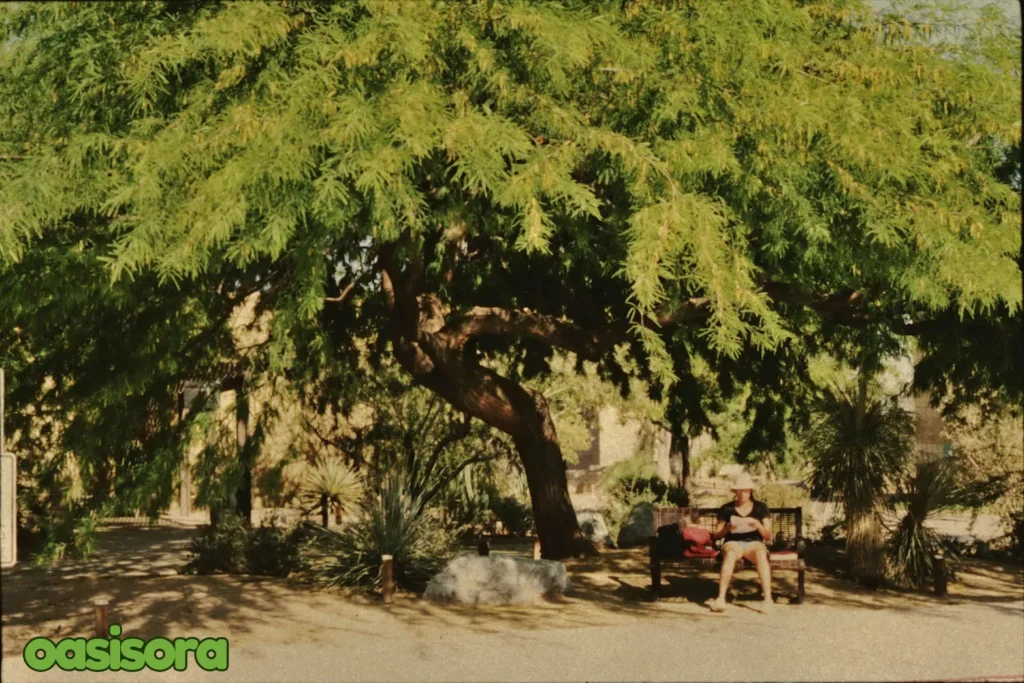
Chilean Thornless Mesquite
Another excellent selection for people who require a small shade tree is the Chilean Thornless Mesquite.
With dark green leaves and tiny thorns, it may attain a height of 20 to 35 feet and spread over an area of 20 to 30 feet.
- Key Features: This smaller tree with a dense canopy, grows quickly and is perfect for wind blocking or privacy. It is simple to maintain and highly useful in dry conditions because it is sturdy, drought-tolerant, and almost thornless.
- Why It Stands Out: It is highly useful in dry conditions because it is sturdy, tolerant of severe drought, and almost thornless.
3. Ironwood (Olneya tesota)
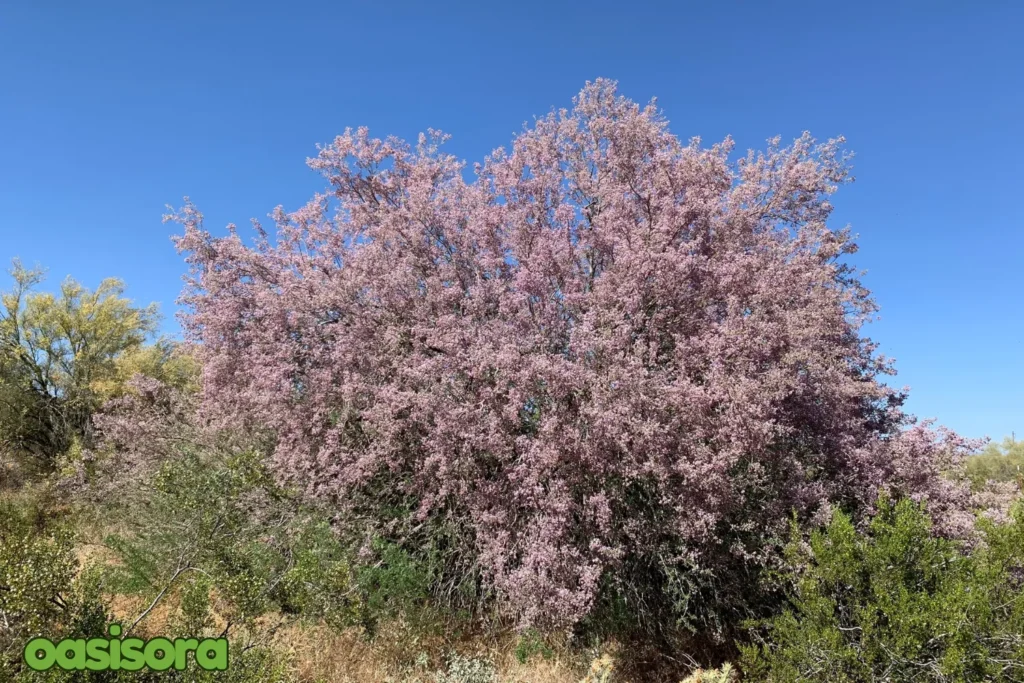
Ironwood (Olneya tesota)
The Ironwood tree offers excellent shade through its enormous, evergreen leaves.
- Key Features: Ironwood sparkles out against Arizona’s desert environment due to its vibrant purple blooms and thick, dense foliage. This tree, which adds elegance and durability to any yard, is renowned for its exceptionally durable wood.
- Ideal For: It serves particularly well for small to medium-sized yards since it provides filtered shade while being hardy and compact in harsh conditions.
4. Ficus Nitida (Indian Laurel Fig)
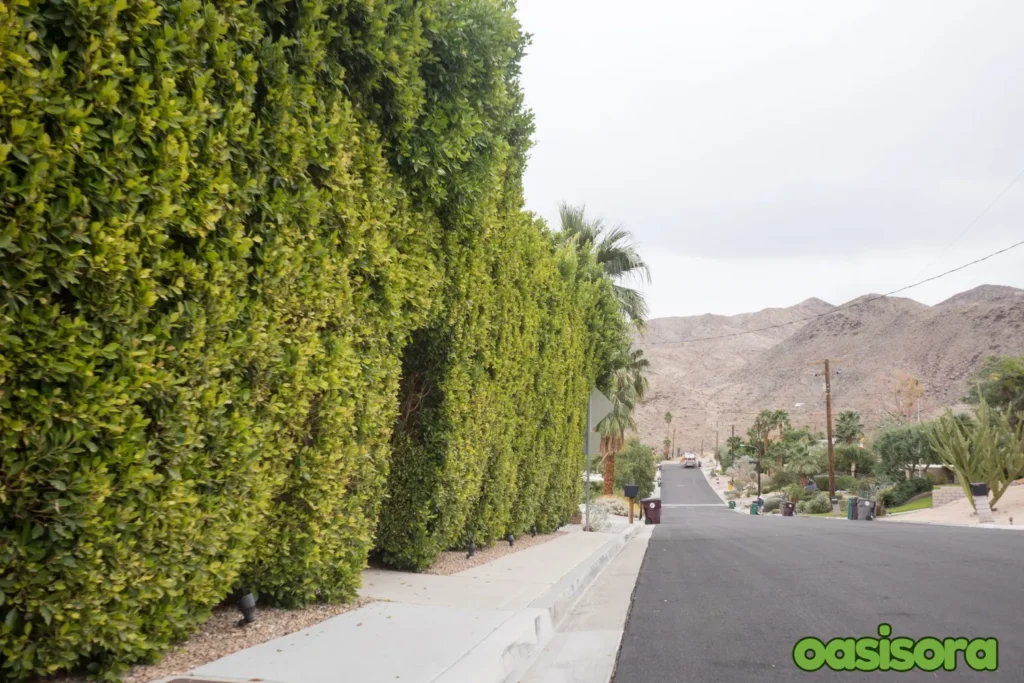
Ficus Nitida (Indian Laurel Fig)
Having the great ability to grow for different soil types, Ficus nitida is a flexible choice for a range of landscape purposes.
- Key Features: Ficus Nitida’s rapid growth, which can reach 35 to 45 feet in height while offering a dense canopy that provides quick cooling. Its large, vibrant leaves enhance the landscape and offer superb shade during the scorching hot months.
- Considerations: Though it can tolerate drought, Ficus nitida depends on persistent care and consistent watering, particularly during periods of severe dehydration. The tree can thrive and keep its lush appearance all year long under adequate maintenance.
5. Tipu Tree (Tipuana tipu)
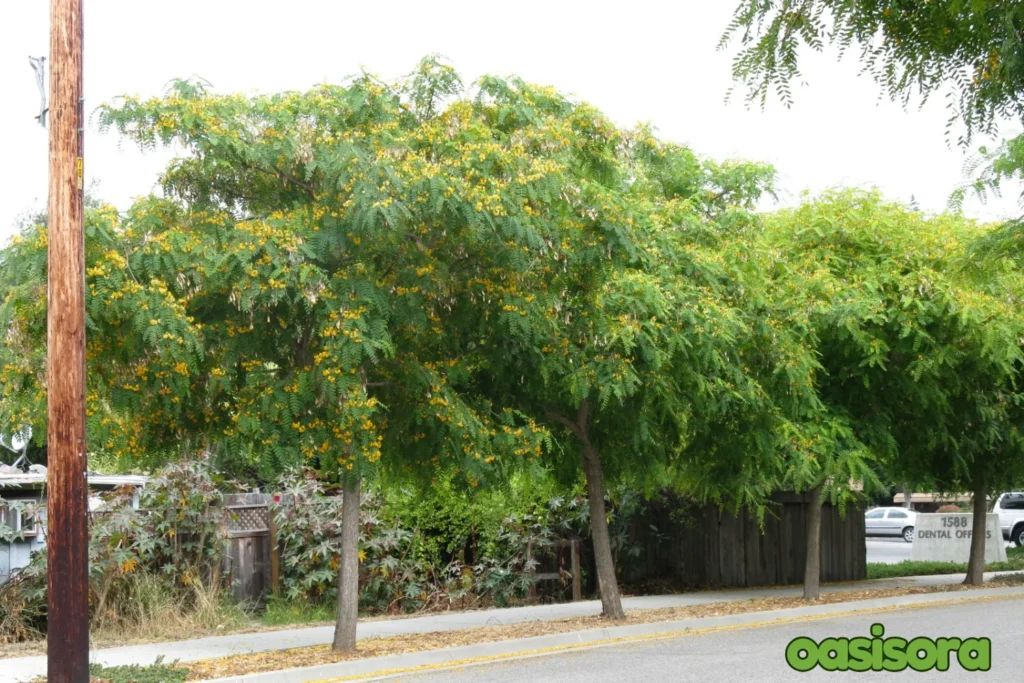
Tipu Tree
Another one of the best shade trees for Arizona is the Tipu tree which grows fast and may attain an adorable height of 40 to 50 feet in just a few years.
- Key Features: The Tipu tree is widely recognized for its lovely golden blossoms and wide canopy that provides adequate shade. It exists in any setting due to its speedy growth and fascinating appearance.
- Best For: With its broad canopy, it offers an immediate solution for chilling your yard, thus making it the perfect choice for homeowners searching for shade in larger spaces.
6. Southern Live Oak (Quercus virginiana)
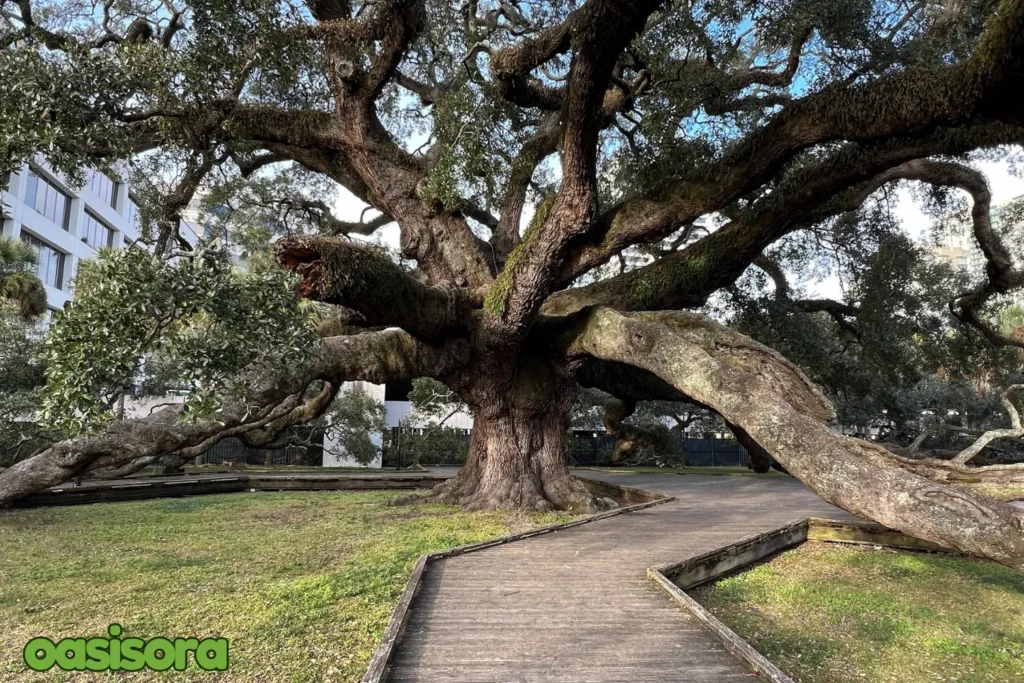
Southern Live Oak
The Southern Live Oak spreads slower than the Ficus nitida, yet it ultimately reaches a height of 25 to 50 feet.
- Key Features: The evergreen leaves and sturdy, traditional look of the Southern Live Oak are its main characteristics. Its broad, thick foliage offers superb year-round cover and beauty.
- Why Choose It: This tree is a dependable, simple-to-maintain option for adding long-term shade to your yard because of its extended lifespan and outstanding wind resistance. It is an excellent asset to any environment as it develops well in a variety of situations.
7. Chinese Elm (‘True Green’) (Ulmus parvifolia)
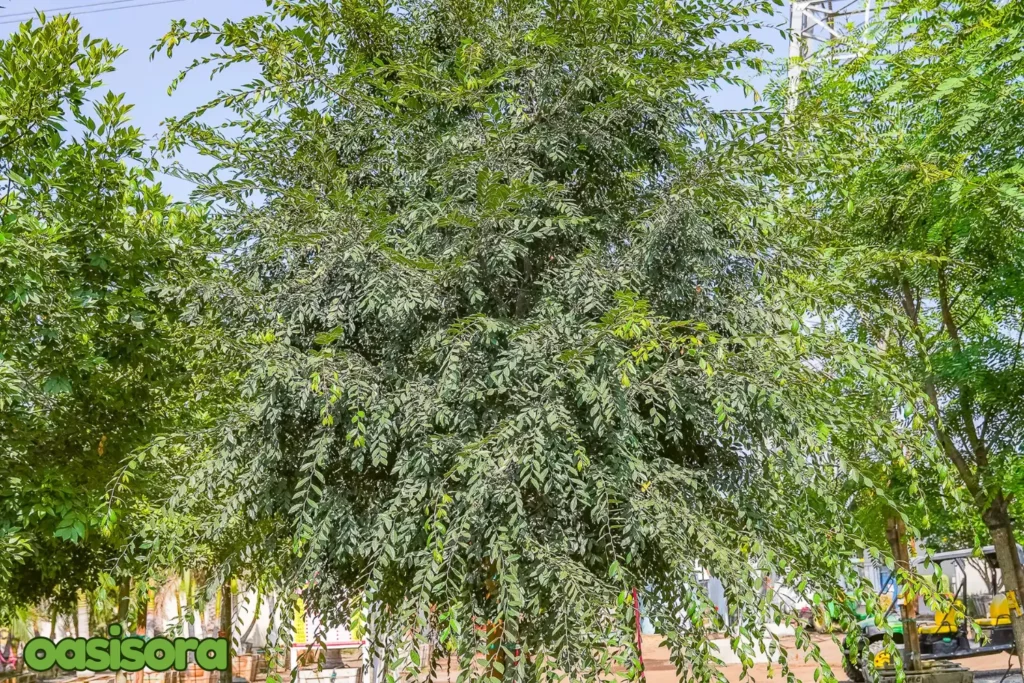
Chinese Elm
Known for its compact form and versatility, the Chinese ‘True Green’ Elm is a great option for landscaping.
- Key Features: Throughout the year, its colored bark offers an unusual aesthetic aspect and appealing beauty. The tree’s lush leaves provide shading from the sun and form a broad, comforting canopy. This tree thrives well even in harsh climes, making it perfect for regions with little rainfall.
- Why It Works: It is a suitable tree for parks, urban settings, and wide open areas due to its versatile nature. Chinese Elm can flourish in a range of soil types and provide adequate resistance to common pests and diseases. It seamlessly combines beauty and functionality whether it grows in open areas or alongside streets.
8. Red Push Pistache (Pistacia chinensis ‘Red Push’)
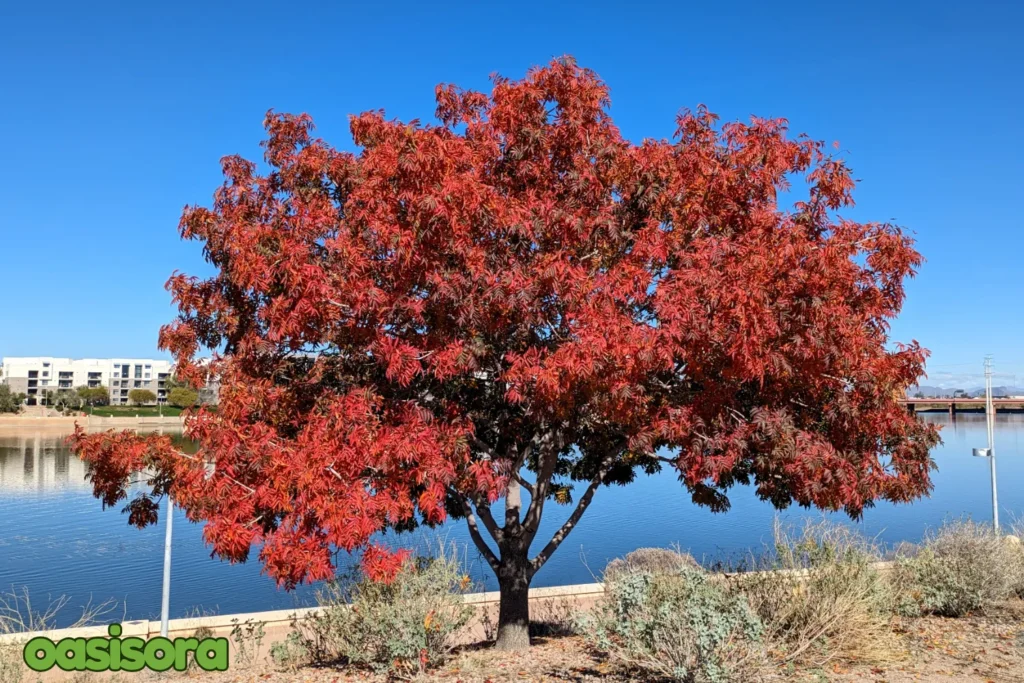
Red Push Pistache
The Chinese ‘Red Push’ Pistache can certainly bring some color to your surroundings with its beautiful red leaves. It blooms in full sun and acquires a height of 20 to 30 feet a bit slowly.
A remarkable option for your natural settings, the Red Push Pistache (Pistacia chinensis ‘Red Push’) combines strength and beauty.
- Key Features: Among the best shade trees for Arizona, Red Push Pistacia yields a spectacular seasonal display in the fall with its lovely red and orange tones. It flourishes in various soil types and climates, with excellent drought resistance after being planted.
- Best For: For homeowners and landscapers, who want seasonal color and year-round cooling shade, this tree is ideal. It is perfect for streets, parks, and backyards due to its symmetrical canopy and low maintenance needs, which increase both usefulness and visual appeal.
9. Majestic Ash (Fraxinus uhdei)
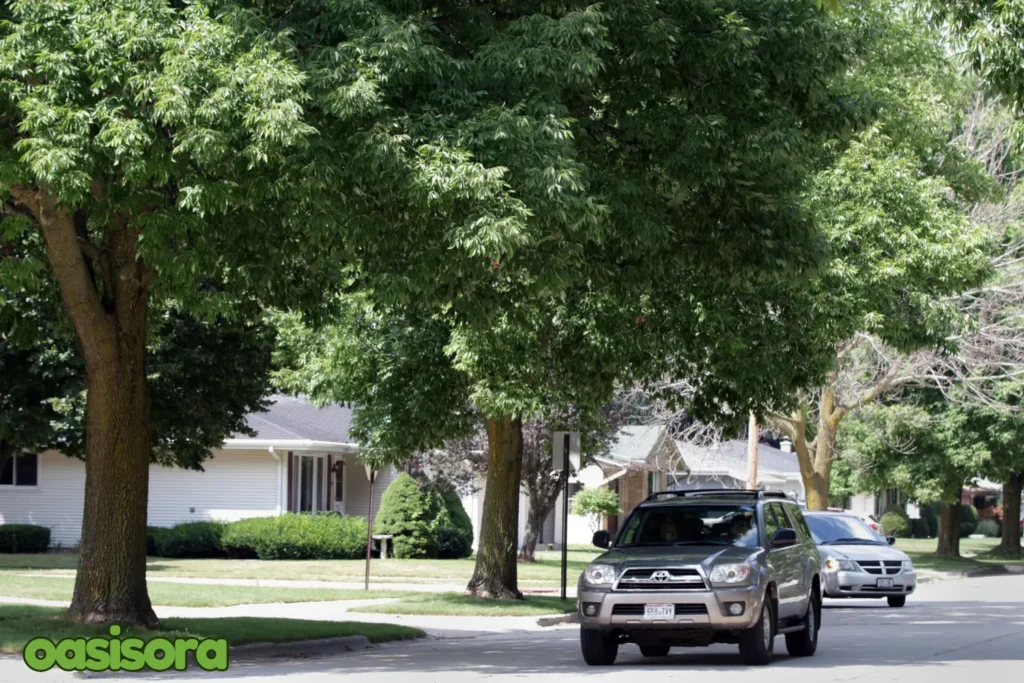
Majestic Ash
A popular option for rapidly generating lush, shady settings is Majestic Ash (Fraxinus uhdei), which will reach a height of 50 to 70 feet.
It is adaptable to a wide range of soil types under various circumstances and has a canopy that spreads widely.
- Key Features: It looks glossy and lively because of its thick, green leaves. The tree’s smooth, well-balanced crown offers plenty of shade and a visually stunning architectural feature.
- Ideal Use: This shade tree, which spreads quickly, is ideal for your home yards and streets because it offers a cool, inviting atmosphere. Its elegant appearance and low maintenance needs attract landscapers to grow it for a calm and cool atmosphere.
10. Shumard Oak (Quercus shumardii)
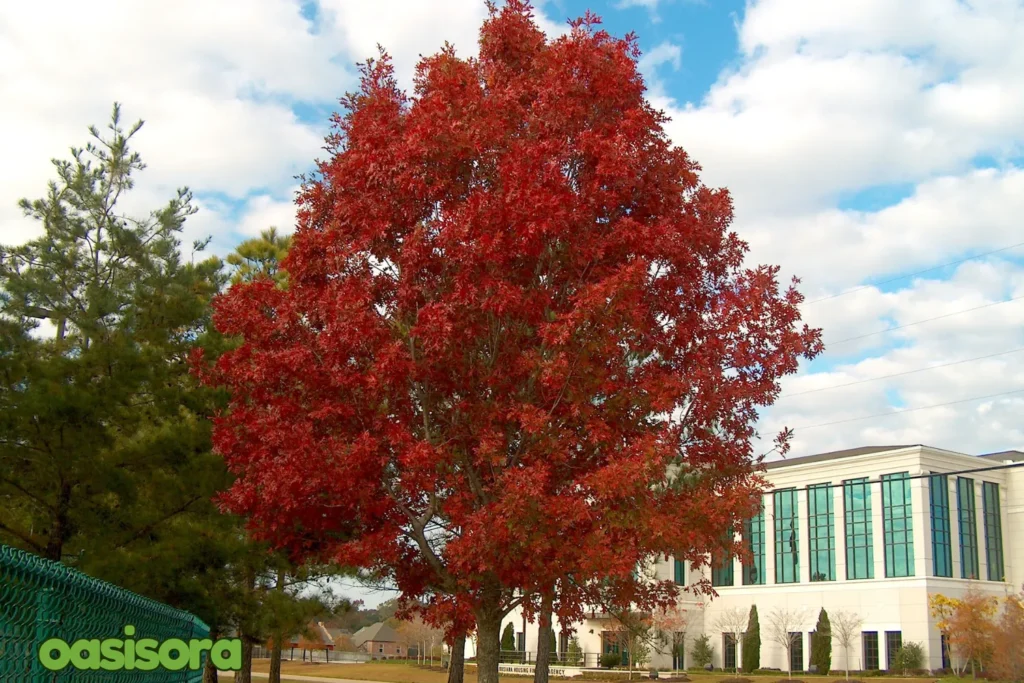
Shumard Oak
With the significant attribute of low upkeep, Shumard Oak (Quercus shumardii) has a uniform and natural widespread.
It is widely appreciated for adding charm and shade to your surroundings as it can achieve a height of 40 to 50 feet.
A favorable choice for many landscape designers, it may provide plenty of shade for outdoor spaces like patios and decks, thus making it ideal for big yards.
- Key Features: Its brilliant green foliage that changes to deep red in the fall provides seasonal attraction. Thrives in a range of soil types and climates, ensuring stability and long-term growth.
- Why it’s loved: This tree is great for public and residential areas because of its extensive canopy and persistent shade. Unique qualities of easy to care for and protection from pests and diseases, make it an effective option for everyone searching for a stylish shade tree.
11. Fruitless Olive (Olea europaea ‘Wilsonii’)
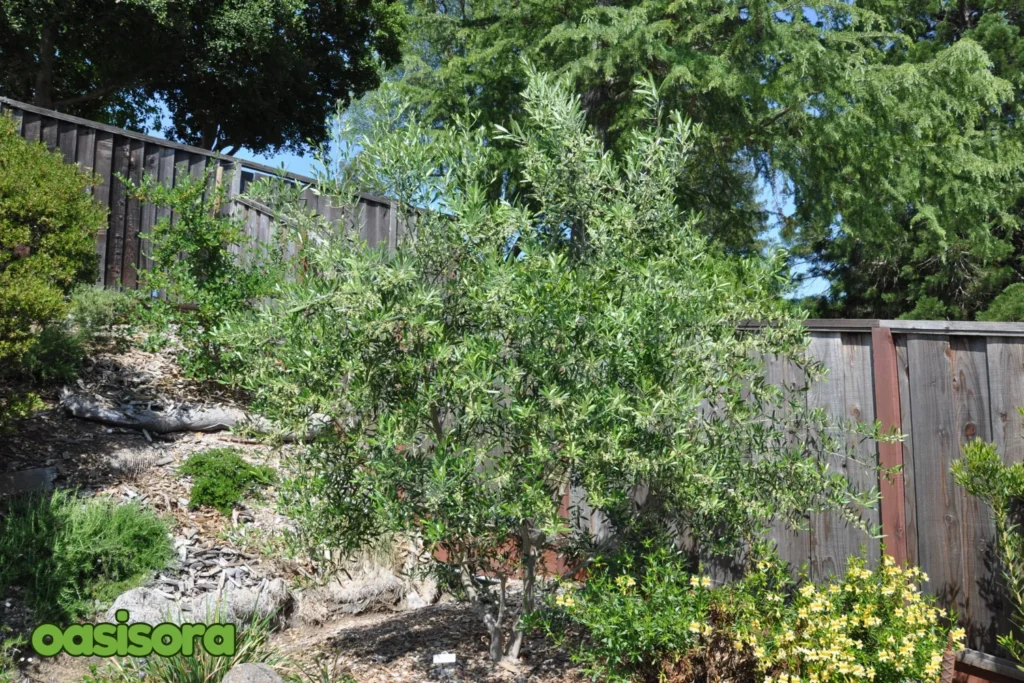
Fruitless Olive
One of the best shade trees for Arizona involves fruitless olive, as it can attain a remarkable height of approximately 35 feet and spread over a large area.
Possessing a thick, oval-shaped canopy, it is highly tolerant to extreme weather particularly strong wind, heat, and drought.
- Key Features: Its soft and silvery foliage gives it a beautiful and refined appearance. Prevents the mess caused by dropped fruit while retaining the splendor of olive trees. It is ideal for outdoor use since it offers refined shade.
- Why It’s Popular: This tree is a favorite option for patios, courtyards, and walks because of its Mediterranean charm and versatility.
12. Texas Ebony (Ebenopsis ebano)
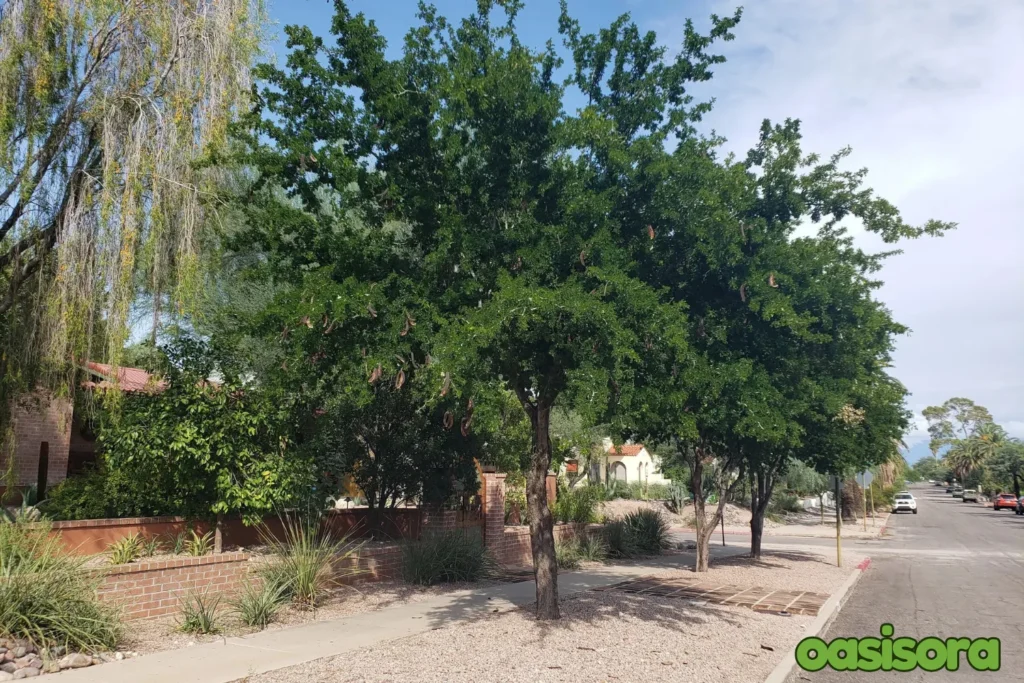
Texas Ebony
The Texas Ebony, or Ebenopsis ebano, is a broad and captivating tree that is appropriate for accent planting or smaller areas.
- Key Features: Its lush canopy provides shade and tranquility to your area throughout the year. Produces sweet-smelling, creamy blossoms that increase the appeal of the season. They can endure drought and are tolerant of desert conditions.
- Best Fit: This tree combines beauty and utility, making it perfect for small yards or as a centerpiece close to entryways. It stands out in any garden layout due to its precise growth habit and pleasing appearance.
Specialty Shade Trees for Different Needs
Fast-Growing Shade Trees
- Tipu Tree: This tree rapidly offers plenty of shade and is praised for its golden-yellow blooms along with its swift growth.
- Desert Museum Palo Verde: A gorgeous hybrid with bright yellow blooms and green bark, optimal for hot conditions.
- Chilean Thornless Mesquite: Quickly developing with a massive canopy, suitable for providing shade in hot environments.
Low-maintenance and Drought-Tolerant Trees
- Ironwood: Gray-green leaves, small blooms, and a very sturdy plant that demands very little water.
- Chinese Elm: A durable tree that looks good in urban areas, with a thick canopy and lovely bark.
- Desert Museum Palo Verde: This plant excels in harsh conditions with little maintenance, combining beauty and drought durability.
- Screwbean Mesquite (Prosopis pubescens): Features with spiral-shaped, unique seed pods screwbean is a unique, versatile, and easily identifiable tree. It needs little to no care and blossoms well in low-lying, moist desert regions like washes. The tree is beneficial for attracting birds and other useful creatures besides providing light and filtered shade.
Ornamental and Evergreen Shade Trees
- Fruitless Olive: Features a dense covering and graceful silver-green leaves without the clutter of fruit.
- Ficus Nitida: A heavily dense, gorgeous evergreen that delivers year-round shade, and peace.
- Southern Live Oak: An outstanding tree with evergreen foliage and expanding branches is appropriate for broad regions.
- Mastic Tree (Pistacia lentiscus): Although it shows slow development, the mastic tree is an evergreen type that thrives well in hot, dry climates. It has little red berries that promote its beautiful appearance along bright and shiny, fragrant leaves. It is outstanding for low-water surroundings due to its compact shape and ability to withstand drought conditions.
Native Arizona Shade Trees
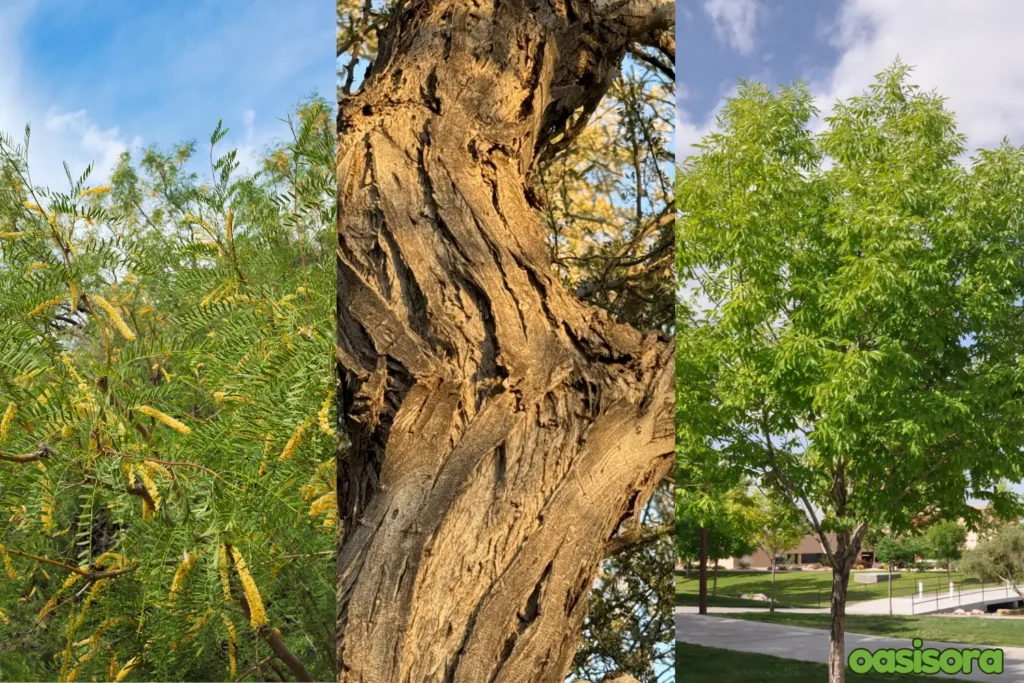
Arizona Shade Trees
Native trees are ideal alternatives for low-water, environmentally conscious landscaping as they are ecologically suitable in Arizona. Beyond giving beautiful scenery to desert yards, these kinds of plants help to nourish nearby wildlife.r
Velvet Mesquite (Prosopis velutina): With fluffy foliage as well as deep roots, velvet mesquite is a native of the desert. It delivers adequate shade and grows well in hot, arid climates. With blooms and seed pods, the tree also offers nutritious food to birds and pollinators and a wonderful source of sweet honey for its community.
Its beautiful twisted trunk makes Mesquite fit and develop elegance in any outdoor setting.
Blue Palo Verde (Parkinsonia florida): The Blue Palo Verde is an amazing and durable plant widely renowned for its blue-green wood and golden-yellow blossoms. Once cultivated, it demands not much moisture and grows well near dry desert stream beds instead of slopes. Requires full daylight with limited nutrient soil to grow ideally.
This tree presents seasonal color and light shade. It’s admirable for natural wildlife due to the presence of sweet pollinated nectar and edible pods, besides delivering sufficient shade in desert areas.
Desert Ironwood (Olneya tesota): It is a durable native tree with lavender-purple blooms, having favorable bean-like seeds which can be roasted and eaten. With extremely dense, dark brown hardwood, its flowers emerge in summer.
This long-lived tree expands slowly, creates an effective canopy that gives off refined shade. Due to its deep roots, it can tolerate drought and is optimal for settling desert soil. Its branches provide a perfect habitat for wildlife to find the right accommodation and food.
Arizona Ash (Fraxinus velutina): A type of deciduous tree that flourishes quickly and widely up to a height of 30 feet, the Arizona Ash is beneficial for irrigated yards or wetland zones. In the heat of the summer, it builds up a thick canopy that delivers deep shade.
When given adequate attention, it provides swift heat relief and adequate greenery to barren landscapes. A moderate watering plan is essential for its rich and strong development.
Best Deciduous Shade Trees
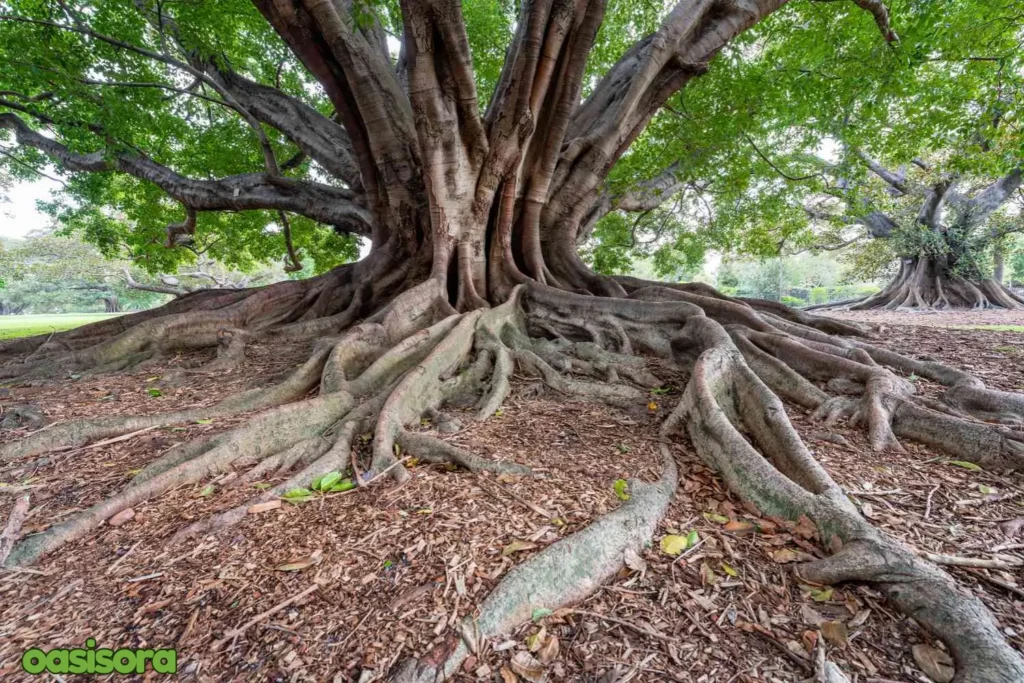
Dedicious Shade tree
Deciduous trees offer perfect shade in the hot season and pass direct sunlight in the cooler months of the year. They drop their thick foliage in the autumn season and regrow in the sprouting period of spring. Ideal for creating an environment-friendly landscape and to impart seasonal beauty due to their flexible growth nature.
Raywood Ash (Fraxinus oxycarpa ‘Raywood’): The soft, structured, quickly developing leaves of Raywood Ash finally become a deep reddish-purple in the autumn period. In hot weather, the tree provides wide shade through its full, balanced foliage.
This tree is compatible with various kinds of soil and accommodates heat well. It’s an excellent option for both looks and functionality.
Red Push Pistache (Pistacia chinensis ‘Red Push’): This hybrid pistache tree can be recognized by its lively red-orange foliage, especially in the Fall season. It brings stunning color in the autumn time and supplies great shade in the height of summer.
Once set up, it is easy to care for and tolerant of dry conditions, making it perfect for a harsh desert atmosphere. It mostly rises in an upright direction, making it suitable for yards or streets.
Bonita Ash (Fraxinus velutina ‘Bonita’): A modified form of the native Arizona ash, bonita ash, adapts quickly and has a full shade structure. With mild watering, it thrives in hot climates while offering deep, shady conditions.
The tree is widespread in residential areas because of its consistently wide shape, having broad leaves. It proposes summertime relief and off-season leaf drop to offer full sunlight.
Expert Tips for Choosing and Planting Shade Trees in Arizona
- Watering Needs: To promote powerful root growth during the plant’s development phase, regular watering is crucial. Most shade trees are drought-resistant as they reach maturation, requiring only periodic heavy irrigation during prolonged dry periods.
- Placement for Maximum Shade: Grow the best shade trees for Arizona on the south or west side of your residence for the most effective cooling effects. By avoiding the strong afternoon sun, this shading system lowers energy expenses and keeps your house fresh and calm.
- Soil Considerations: In regions with a lot of clay, you must improve drainage because trees require well-drained soils. If possible, think about implementing raised planting beds to safeguard root health and avoid waterlogging.
- Tree Maintenance: Shaping the tree once a year is essential to maintaining its shape while supporting strong growth. To increase airflow, eliminate the risk of pests, and protect the tree’s structural integrity, remove unwanted dead or flipped branches.
Final Thoughts
Cool Your Desert Oasis with Shade Trees
The shade trees are a vital element of any Arizona landscape, bringing both aesthetic appeal and functionality. These plants not only enhance the visual appeal of your outdoor areas but also produce crucial shade, which makes the surrounding environment more comfortable and cool. Picking the best shade trees for Arizona that are compatible with the desert environment guarantees that they will grow well with little water and save energy while benefiting the local ecology.
There is a tree that fits every yard, including fast-growing and drought-tolerant types. To transform your area into a greener, cooler oasis and enjoy its benefits for years to come, begin cultivating such plants now!.
FAQs
What is the fastest-growing shade tree in Arizona?
The Tipu Tree is set apart through its vast canopy, bright yellow blossoms, and relatively rapid growth.
What is the best tree for Arizona heat?
The Desert Museum Palo Verde’s drought-resistant qualities, bright yellow blooms, and potential to offer plenty of shade enable it to flourish in Arizona’s extreme temperatures.
What trees thrive in Arizona?
Mesquite, ironwood, palo verde, and Chinese elm represent some best shade trees for Arizona because of their low water requirements and ability to adapt to desert environments.
What is the best tree in Arizona that doesn’t shed?
With its substantial shade, evergreen beauty, and insufficient fruit drop, the Fruitless Olive is an awesome option.

4 thoughts on “12 Best Shade Trees for Arizona to Beat the Heat Naturally”
Comments are closed.